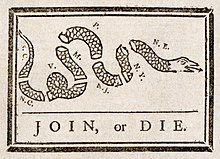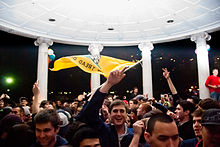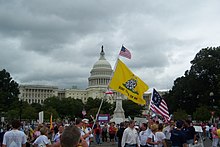In modern times, the Gadsden flag is often associated with political movements such as libertarianism and the American Tea Party, and has been used by U.S. Soccer supporter groups including Sam's Army
and The American Outlaws since the late 1980s.
and The American Outlaws since the late 1980s.
Snake symbolism[edit]
Only the timber rattlesnake occurs throughout the area of the original Thirteen Colonies. Its use as a symbol of the American colonies can be traced back to the publications of Benjamin Franklin. In 1751, he made the first reference to the rattlesnake in a satirical commentary published in his Pennsylvania Gazette. It had been the policy of Great Britain to send convicted criminals to the Americas, so Franklin suggested that they thank the British by sending rattlesnakes to England.[1]
In 1754, during the French and Indian War, Franklin published his famous woodcut of a snake cut into eight sections. It represented the colonies, with New England joined together as the head and South Carolina as the tail, following their order along the coast. Under the snake was the message "Join, or Die". This was the first political cartoon published in an American newspaper.
As the American colonies came to identify more with their own communities and the concept of liberty, rather than as vassals of the British empire, icons that were unique to the Americas became increasingly popular. The rattlesnake, like the bald eagle and American Indian, came to symbolize American ideals and society.[2][not in citation given]
As the American Revolution grew, the snake began to see more use as a symbol of the colonies. In 1774, Paul Revere added Franklin's iconic cartoon to the nameplate of his paper, the Massachusetts Spy, depicted there as fighting a British dragon.[3] In December 1775, Benjamin Franklin published an essay in the Pennsylvania Journal under the pseudonym American Guesserin which he suggested that the rattlesnake was a good symbol for the American spirit:
The rattlesnake symbol was first officially adopted by the Continental Congress in 1778 when it approved the design for the official Seal of the War Office (at that time and for many years thereafter, the War Office was a term associated with the Headquarters of the Army). At the top center of the Seal is a rattlesnake holding a banner which says: "This We'll Defend". According to the US Army's Institute of Heraldry, "'This We'll Defend,' on a scroll held by the rattlesnake is a symbol depicted on some American colonial flags and signifies the Army's constant readiness to defend and preserve the United States.' This design of the War Office Seal was carried forward - with some minor modifications - into the subsequent designs for the War Department's Seal, and the Department of the Army's Seal, Emblem and Flag. As such, the rattlesnake symbol has been in continuous official use by the US Army for over 236 years.
Gadsden's flag[edit]
In fall 1775, the Continental Navy was established by General George Washington in his role as Commander in Chief of all Continental Forces, before Esek Hopkins was named Commodore of the Navy. The Navy began with seven ships, often called "Washington Cruisers", that flew the "Liberty Tree Flag", depicting a green pine tree with the motto "Appeal to Heaven" according to the October 20, 1775 letter of Washington's aide Colonel Joseph Reed, that is in the Library of Congress. The illustration on this page shows four flags, the one in the upper left is a common artist's rendition, but is incorrect at least as far as the motto, which is "Appeal to Heaven", not "AN APPEAL TO HEAVEN" according to the letter from Washington's aide, and Caslon was the common typeface of the day, used on both the Declaration and the Constitution, not the sans serif typeface shown on the flag image.
Those first ships were used to intercept incoming British ships carrying war supplies to the British troops in the colonies to both deprive the supplies to the British and to supply to the Continental Army. One ship captured by Captain John Manley had 30,000 pairs of shoes on it, but the admiralty agent demanded his 2 1/2 per cent commission before he would release the cargo for Washington's army, so many soldiers marched barefoot in the snow. To aid in this, the Second Continental Congress authorized the mustering of five companies of Marines to accompany the Navy on their first mission. The first Marines enlisted in the city of Philadelphia, and they carried drums painted yellow, depicting a coiled rattlesnake with thirteen rattles, and the motto "Don't Tread on Me." This is the first recorded mention of the future Gadsden flag's symbolism.[citation needed]
At the Congress, Continental Colonel Christopher Gadsden represented his home state of South Carolina. He was one of seven members of the Marine Committee who were outfitting the first naval mission.[5]
Before the departure of that first mission in December 1775, the newly appointed commander-in-chief of the Navy, Commodore Esek Hopkins, received the yellow rattlesnake flag from Gadsden to serve as the distinctive personal standard of his flagship. It was displayed at the mainmast.[5]
Gadsden also presented a copy of this flag to the Congress of South Carolina in Charleston, South Carolina. This was recorded in the South Carolina congressional journals on February 9, 1776:
Variations in appearance[edit]
Many variations of the Gadsden flag may be found:
- The motto sometimes includes an apostrophe in the word "Don't" and sometimes does not. Early written discussions uniformly include an apostrophe; however, as early as 1917 a flag reference book includes a picture of a version without the apostrophe.[5]
- The typeface used for the motto is sometimes a serif typeface and other times sans-serif.
- The rattlesnake sometimes is shown as resting on a green, presumably grassy, ground, and sometimes not. The green grass seems to be a recent addition; representations dating from 1885 and 1917 do not display anything below the rattlesnake.
- The rattlesnake usually faces to the left, and the early representations mentioned above face left. However, some versions of the flag show the snake facing to the right.
Other rattlesnake flags[edit]
The Culpeper Minutemen flag has a coiled rattlesnake and the same motto as the Gadsden flag. It has a white field, rather than yellow, and the additional motto "Liberty or Death" and the name "The Culpeper Minute Men". It is the flag of Virginia volunteers from the Culpeper area.
The John Proctor's Regiment flag of 1st Battalion Westmoreland County, Pennsylvania, had a coiled rattlesnake shown on its flag.[7]
The Rhode Island Militia Artillery also used a coiled rattlesnake on its flag. Before Esek Hopkins was named the first Commodore of the American Navy by the Continental Congress, where his brother Stephen Hopkins was an influential member of the Maritime Committee, Esek Hopkins served as a Brigadier General of the Rhode Island Militia Artillery, so would have been very welcoming to the Gadsden flag that also had a coiled rattlesnake. Despite the Rhode Island Artillery declining to provide any cannon to outfit the first seven ships of the American Navy commissioned by Washington, Hopkins was "loaned" about 200 men from Washington's Army to help him man his ships, but he was slow in "repaying" the loan according to correspondence from the Commander in Chief Washington. Commodore Esek Hopkins did not do well in command, and was relieved by the Continental Congress after an ill-fated raid on New Providence in the Bahamas.[citation needed]
All four of the American-designed "Rattlesnake Flags" show a coiled rattlesnake. The only other rattlesnake flag, the First Navy Jack, was "designed by" the English artist Thomas Hart as background art.[citation needed]
The traditional version of the First Navy Jack has an uncoiled rattlesnake and the same motto as the Gadsden flag, on a field of 13 horizontal red and white stripes. Flag experts (vexillologists) speculate that the English artist Thomas Hart either did not know about the practice of rattlesnakes to coil in defense, or did, and intended to insult the fledgling American Navy as a weak and vulnerable creature as a rattlesnake is when not coiled and ready to strike, slithering on the ground, trying to escape, with its motto "[Please] Don't Tread on Me!" However, others[who?] suggest the snake pictured on the flag was being provoked, and is striking. Hence the warning, "Don't tread on me [or I will strike]".[citation needed]
Contemporary significance[edit]
Considered one of the first flags of the United States, the flag was later replaced by the current Stars and Stripes (or Old Glory) flag. Since the Revolution, the flag has seen resurgences as a symbol of American patriotism, disagreement with government, or support for civil liberties.
The First Navy Jack, which was not directly related to the Gadsden flag, has been in use by the United States Navysince its beginnings. Unlike the Liberty Tree Flag with the letter by Colonel Joseph Reed that describes it, there is no document that describes the Snake on Stripes flag, only an image by English artist Thomas Hart in the background of a portrait of Commodore Esek Hopkins. In that same painting is a round "tree flag". The triangular Liberty Tree flag is derived from the only surviving tree flag from the Revolution, found in an old trunk in 1993 on Long Island, the 5th Regt. Connecticut Militia. The Snake on Stripes flag was included in a book of flags by Admiral Preble, but later Preble determined the flag not valid, so removed it from his text. However, the book publisher used the old color plates, so the image was continued in the new edition, and subsequently picked up by other publications and Webster's Dictionary.[citation needed]
In preparation for the bicentennial year 1976, staff officers in the Secretary of the Navy's office sought a powerful image for the Navy's Bicentennial. One Navy officer saw the Snake on Stripes Flag in Webster's Dictionary, so the staff officers ordered a large number to give away as Navy promotional items, and then turned to the Naval Historical Center to "get the history". They were told that the flag had probably never flown during the Revolution, based on Admiral Preble's later discoveries, but a decision was made to use the Snake on Stripes Flag, or the "Fake Snake Flag", anyway. Beginning in 1975, commissioned Navy ships flew this Jack in place of the Naval Jack (officially known as the Union Jack, not to be confused with the United Kingdom's Flag) at the bow. In 1977, the Secretary of the Navy directed that the ship in active status with the longest total period of active service shall display the First Navy Jack until decommissioned or transferred to inactive service, at which time the flag shall be passed to the next ship in line with appropriate honors. The display of this jack by the oldest ship in the fleet is intended as a form of recognition to promote pride of service, enhance morale, and contribute to the tradition of naval service. USS Enterprise (CVN 65) became the oldest active ship in the United States Navy upon the decommissioning of USS Kitty Hawk (CV 63) on May 12, 2009. Enterprise is only the third aircraft carrier ever to hold the honor of flying the First Navy Jack.[8]
(Since this article was written, the amphibious command ship USS Blue Ridge (LCC 19), commissioned in 1970, became the oldest active ship in the United States Navy upon the decommissioning of USS Enterprise (CVN 65) in 2014).
Since the first Patriot Day on September 11, 2002, which commemorates the lives lost in the September 11 attacks, the rattlesnake from the flag is also shown on the U.S. Army's Drill Sergeant Identification Badge. After the Snake On Stripes Flag became the Navy's symbol for the Global War on Terrorism, flag history professionals[vague] (vexillologists) have done extensive research papers that further question the claim that the flag ever flew during the American Revolution. Yet it continues to fly at the bow of American warships today.[citation needed]
For historical reasons, the Gadsden flag is still popularly flown in Charleston, South Carolina, the city where Christopher Gadsden first presented the flag, and where it was commonly used during the revolution, along with the blue and white crescent flag of pre-Civil War South Carolina.
Tea Party Movement symbol[edit]
Beginning in 2009 at Tea Party rallies, the Gadsden Flag has been adopted as a symbol of the American Tea Party movement.[9][10][11][12] It was also displayed by members of Congress at Tea Party movement rallies.[13] Some lawmakers have called it a "political symbol" because of this association.[11][14]
In March 2013, a resident of New Rochelle, New York put up a Gadsden flag at the city's vacant armory building. The city ordered its removal, fearing that the flag would be seen as political. The next month, a veterans group, the United Veterans Memorial & Patriotic Association, filed suit against the city.[15]
In popular culture[edit]
Athletic apparel company Nike uses the image of a rattlesnake coiled around a soccer ball for an ongoing, patriotic "Don't Tread on Me" campaign in support of the United States men's national soccer team. The phrase has become a rallying cry for American soccer fans and the Gadsden flag can occasionally be seen at national team games. A representation of the rattlesnake is contained on the inside of their uniforms, over the heart, with the initials "D.T.O.M.", which were used in the 2010 World Cup.[16]
On October 20, 2015 Hal Meyer released his debut acoustic single titled "Don't Tread On Me". The song is a heartfelt anthem for military veterans who have given their lives while serving.
In Hideo Kojima's videogame Metal Gear Solid 2: Sons of Liberty a variation of the flag can be seen on one of the connecting bridges of the "Big Shell" facility, in a reference to both the original meaning and usage of the flag
In the apocalyptic 2006 CBS TV drama Jericho, the flag makes several appearances, most notably in the series finale as Jericho's acting mayor takes down the flag of the "Allied States of America", which had been flying at the town hall following a federal coup. He replaces the red, white, and blue flag of the central government with a Gadsden Flag which the previous mayor had kept framed in his office. The scene depicts a once-collaborative character as finally having summoned the courage to be in open defiance against a supreme government.[17]
The heavy metal band Metallica recorded a song called "Don't Tread on Me" on their self-titled fifth studio album, released in 1991. The album cover features a picture of a coiled rattlesnake almost exactly like the one found on the Gadsden Flag. The song's lyrics refer to the American Revolutionary War.
311's eighth studio album, released in 2005, is titled Don't Tread on Me.
Country music singer Aaron Lewis has the phrase tattooed on his neck. His song "Country Boy", on his 2011 album, Town Line, says that he has two flags flying above his house, the American flag and the Gadsden flag.
NASCAR driver Carl Edwards displays the Gadsden Flag next to his facsimile signature on his race car.
In the popular television series The West Wing, Deputy White House Communications Director Sam Seaborn has the Navy Jack flag on his office wall.
The WWE faction "The Real Americans" (Jack Swagger, Antonio Cesaro, and Zeb Colter) used the flag prominently.
The massively multiplayer online roleplaying game Guild Wars 2 includes an achievement titled "Don't Tread On Me" [19] as a part of the Seeds of Truth mission.






No comments:
Post a Comment